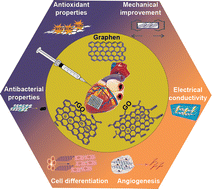Potential of graphene-based nanomaterials for cardiac tissue engineering
Abstract
Cardiovascular diseases are the primary cause of death worldwide. Despite significant advances in pharmacological treatments and surgical interventions to restore heart function after myocardial infarction, it can progress to heart failure due to the restricted inherent potential of adult cardiomyocytes to self-regenerate. Hence, the evolution of new therapeutic methods is critical. Nowadays, novel approaches in tissue engineering have assisted in restoring biological and physical specifications of the injured myocardium and, hence, cardiac function. The incorporation of a supporting matrix that could mechanically and electronically support the heart tissue and stimulate the cells to proliferate and regenerate will be advantageous. Electroconductive nanomaterials can facilitate intracellular communication and aid synchronous contraction via electroactive substrate creation, preventing the issue of arrhythmia in the heart. Among a wide range of electroconductive materials, graphene-based nanomaterials (GBNs) are promising for cardiac tissue engineering (CTE) due to their outstanding features including high mechanical strength, angiogenesis, antibacterial and antioxidant properties, low cost, and scalable fabrication. In the present review, we discuss the effect of applying GBNs on angiogenesis, proliferation, and differentiation of implanted stem cells, their antibacterial and antioxidant properties, and their role in improving the electrical and mechanical properties of the scaffolds for CTE. Also, we summarize the recent research that has applied GBNs in CTE. Finally, we present a concise discussion on the challenges and prospects.

- This article is part of the themed collection: Journal of Materials Chemistry B Recent Review Articles


 Please wait while we load your content...
Please wait while we load your content...